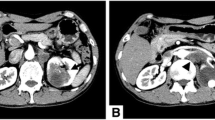Abstract.
Background: To study the biological behavior of renal squamous cell carcinoma (RSCC).
Methods: Fifteen cases of RSCC were retrospectively studied. These cases were classified as central (eight cases) and peripheral (seven cases) types by the tumor location. The clinical data and computed tomographic findings were analyzed and compared.
Results: High incidence (87%) of urolithiasis was observed. The prognosis of RSCC was very poor, with a median survival time of 3.5 months. The infectious symptoms, central location, and modified stage IV of the tumor were the poor prognostic factors of RSCC. Two types of RSCC were different in the presenting symptoms, lymph node metastasis, modified tumor staging, and survival time.
Conclusion: The central and peripheral types of RSCC were different biologically. High index of suspicion should be maintained when identifying the subtle clues of malignancy in patients with urolithiasis.
Similar content being viewed by others
Author information
Authors and Affiliations
Additional information
Received: 15 May 1996/Accepted: 19 July 1996
Rights and permissions
About this article
Cite this article
Lee, TY., Ko, SF., Wan, YL. et al. Renal squamous cell carcinoma: CT findings and clinical significance. Abdom Imaging 23, 203–208 (1998). https://doi.org/10.1007/s002619900324
Published:
Issue Date:
DOI: https://doi.org/10.1007/s002619900324




